What is the bladderwort and how to plant it?
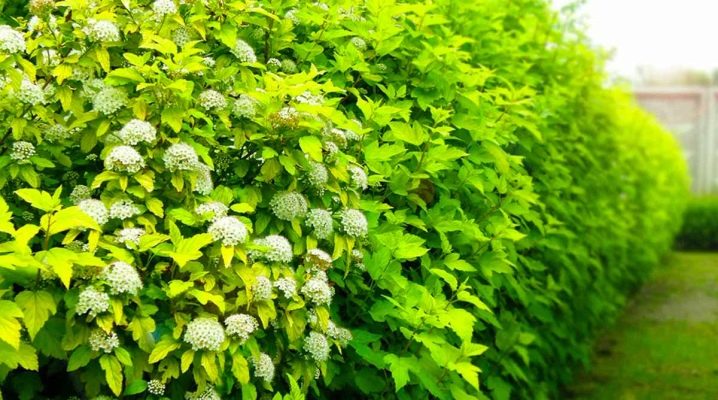
In North America and East Asia, in some areas, you can find an attractive plant with an interesting name - the vesicle. A few decades ago, they began to actively cultivate it, including in Russia. To make the plant look attractive, it is necessary to take proper care of it, which consists of several important activities.
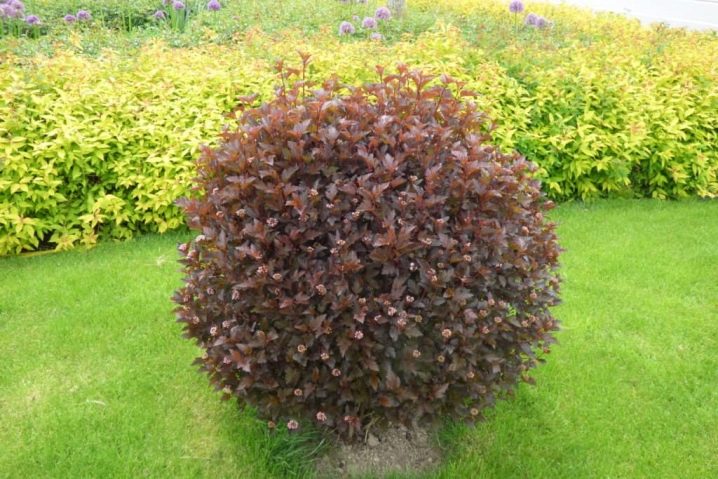
general description
The gallbladder is a deciduous shrub belonging to the Pink family. About 14 plant species are known, but not all of them are cultivated. The bush can be grown both in the southern regions and in the middle lane, and even in the Urals and Siberia. The advantages of growing a vesicle are as follows:
- it is resistant to air pollution, low temperatures, and drought;
- unpretentious in care;
- retains an attractive appearance throughout the growing season;
- the shrub grows rather quickly, the growth rate is possible due to the developed root system.
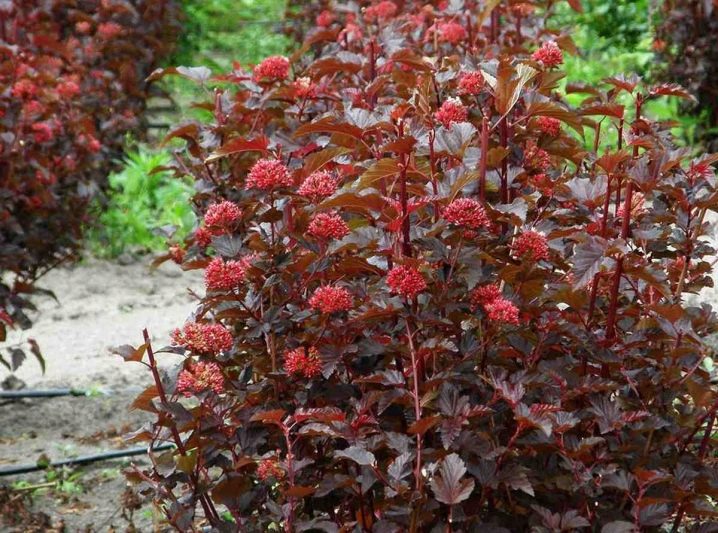
The shrub consists of branches that form a rather lush spherical crown. The shoots reach a height of 3 m. According to the external description, the leaves are very similar to the leaves of the viburnum. The inflorescences are hemispherical, white, 5–7 cm in diameter. The flowering period begins in early summer and lasts for several weeks. When the shrub blooms, you can smell a subtle pleasant aroma.

Shrub fruits are no less attractive. They are presented in the form of swollen red leaflets that look like berries.
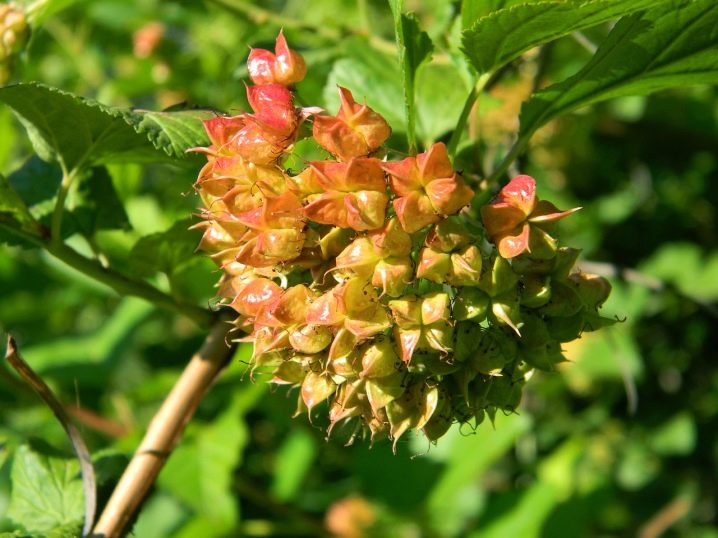
On the trunk of a shrub, as well as on especially large branches, the bark may flake off as it grows. And this happens in large plates.
Types and varieties
There are 2 cultivated species of the vesicle, the representatives of which are distributed according to varieties. The first species is Amur. It grows in the northern parts of Korea and China, and can also be found in the Far East.
It reaches a height of 300 cm, young shoots are smooth, red-brown in color. On older adults, the bark is rough due to longitudinal flaking. The leaves are quite large, up to 10 cm long. The outside is dark green in color and the inside is white-gray because it has a fluffy surface.
The inflorescences consist of several white flowers, no more than 1.5 cm in diameter. The flowering period is on average 20 days. A distinctive feature of this species is its increased frost resistance. The most common varieties are:
- Nana is a dwarf shrub with dark green leaves;
- Luteus - in the summer, the plates are yellow, and in the fall they turn bronze;
- Aureomarginate - a feature of this variety is the presence of a dark golden edging on the leaves.
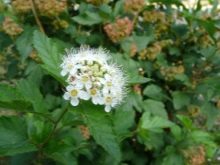
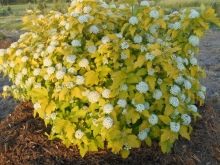
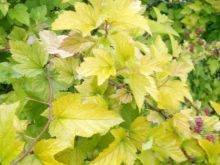
The second type is viburnum bladderwort. It is most often found in North America. It grows along the banks of freshwater rivers, as well as on forest edges. Has a rather lush spherical crown. This type is actively used to create so-called hedges. There are several of the most common varieties.
- Darts Gold - in height most often reaches 150 cm, the leaves are yellow, and the inflorescences have a pink or white tint.
- Red Baron - height about 200 cm.A distinctive feature is the red foliage with a scalloped edging. Umbellate inflorescences are composed of pink and white flowers.
- Lady in Red is a variety bred by English breeders. The flowers are white-pink, the leaves are purple, darken over time.
- Diablo - This decorative variety also has burgundy leaves.
- Purpurea - large red leaves are a feature.
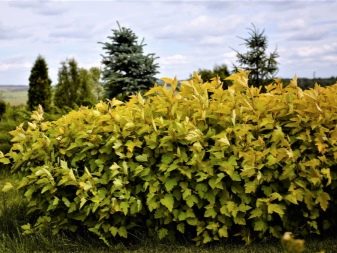
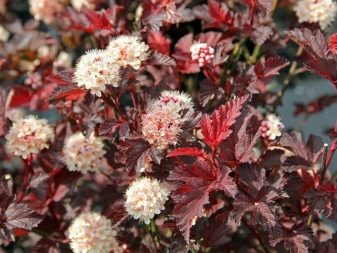
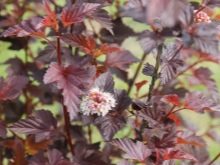
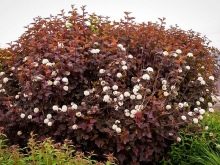
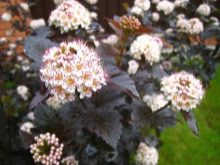
These varieties are most often used by landscape designers, and are also grown by amateur gardeners in their backyards.
Landing
If the seedlings of the bladder plant were purchased in the nursery and have a closed root system, then they can be planted almost at any time at above-zero temperatures (the only exception is winter). Seedlings with open roots are best planted in the fall, before the first frost.
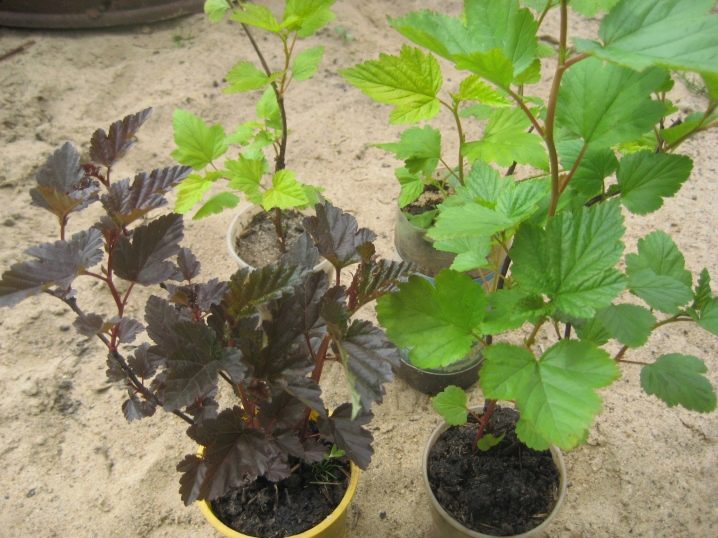
Before planting a plant, it is recommended to select and prepare the most suitable soil area. The ideal option is a well-lit area with no large trees nearby. They are undesirable, since they will take all the nutrients and moisture from the soil. If a bladder with green leaves was chosen for cultivation, then a slightly shaded area is also suitable.
If we talk about the soil, it is better to take care of creating a drainage layer, and also add lime to the soil. For ornamental varieties, loose loamy soil is suitable.
Next, you need to dig holes in the garden at a distance of 50-100 cm from each other, if you are planting several bushes of the vesicle. In the holes you need to lower the root part of the plant along with an earthen lump. It is important to go through this stage as carefully as possible in order to prevent damage to the roots. After planting, it is recommended to mulch the soil around the bush with peat.
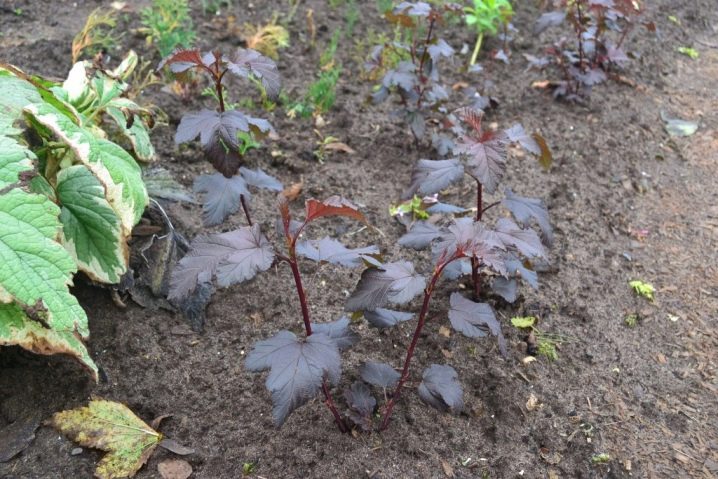
Care
Bladder bushes need timely and proper care, which includes watering, feeding, pruning if necessary and preparing for winter.
Watering
The planted shrub must be watered well. If the soil sags under the influence of moisture, it is recommended to add some more earth.
Then the plant also needs to be watered periodically, as it is considered particularly sensitive to drought. This must be done carefully so that the liquid does not get on the leaves and inflorescences. Failure to do so may result in sunburn. Watering should be done mainly in the morning or in the evening. At least 40 liters of water should go under 1 adult bush.

Top dressing
It is required to apply fertilizers under the plant no more than 2 times a year. It is better to do this in spring and autumn, but you can also feed it in summer. The solution consists of the following components:
- 10 liters of water;
- 500 g mullein;
- 1 tbsp. l. saltpeter;
- 1 tbsp. l. urea.
The components need to be mixed together and pour the mixture under the bush in the spring.
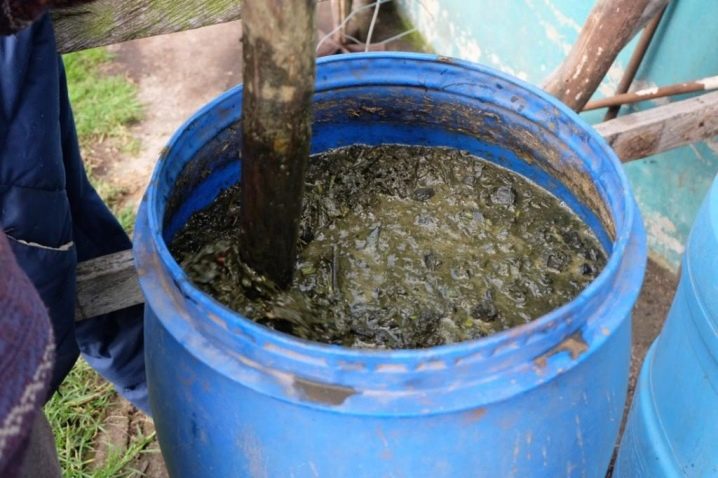
In autumn, it is best to feed with a solution of nitroammophoska (10 liters will require 2 tbsp. L. Of the substance).
Pruning
The shrub must be pruned periodically for sanitary purposes. Also, this procedure is necessary for the formation of an attractive crown. In the spring, diseased and dried shoots are removed without fail. Also, in the spring, the shrub should be pruned for a formative purpose. To obtain the "fountain" shape, it is necessary to remove all small shoots from below, leaving 5-7 strongest branches. The latter can be slightly shortened.
It is also recommended to remove unhealthy branches in autumn. This is necessary in order to prepare the plant for winter. As soon as the vesicle turns 6 years old, it is recommended to carry out a rejuvenating stump pruning, removing virtually all branches. In this case, the sections must be disinfected with a solution of potassium permanganate.
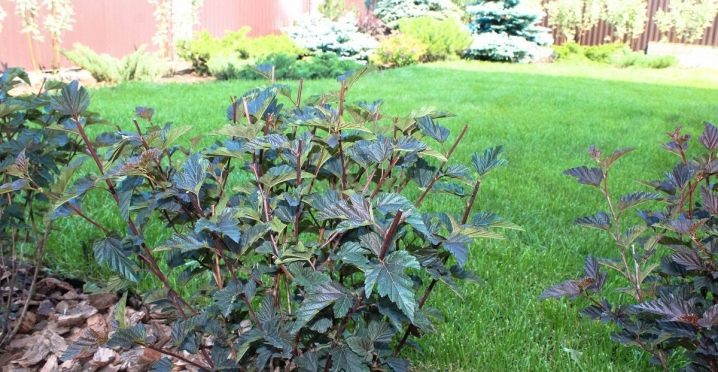
The shrub is transplanted in the spring before the buds swell. This should be done carefully, since significant damage to the root system can completely destroy the plant.
Wintering
It is necessary to care for the bladder from spring to autumn.Winter time for this plant is considered a dormant period.
In regions with cold winters, it is necessary to cover the bushes. To do this, all branches need to be well pulled together with twine, and then use a cone made of roofing material or other identical material for shelter. It should be opened only with the arrival of warm spring days.

Reproduction
The gallbladder is capable of propagating by cuttings. They need to be cooked before the plant blooms. The optimal length of the segments is from 10 to 15 cm, while each of them should have from 2 to 3 internodes.
The sheet plates that are in the lower part are removed. It is recommended to shorten the upper ones by about 50%. The further process consists of several stages.
- Prepared cuttings should be placed in Kornevin or any other similar solution.
- Then they are planted in a temporary place in a greenhouse. At this stage, it is necessary to water the layers in a timely manner and ventilate the mini-greenhouse.
- They should be covered for the winter, and transplanted to the main place next spring.
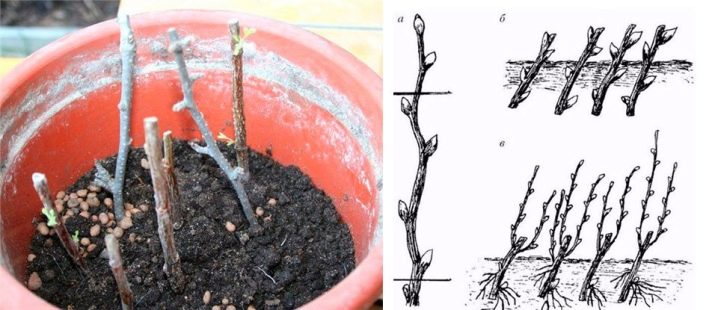
A simpler and more effective method of propagation is by layering. To do this, it is enough to choose the strongest outer stem, place it in the prepared groove, and root it there using special staples.
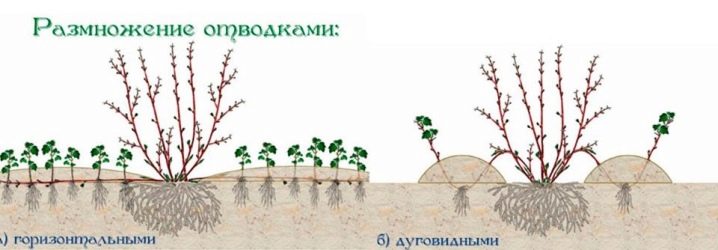
After that, you need to water, and in the fall, separate the layers from the common bush and plant.
Diseases and pests
The gallbladder is resistant to various diseases, as well as to attacks of insect pests. But if the rules of agricultural technology are violated, some diseases still appear. Chlorosis is considered the most common. The main symptoms: drying out of the stems and leaf plates.
For the treatment of the disease, it is necessary to spray with a solution of "Ferovit" or "Antichlorosis". Iron chelate can also be used.

Of the pests, meadow moths and aphids most often attack the bushes. The use of biological pesticides is recommended for pest control.
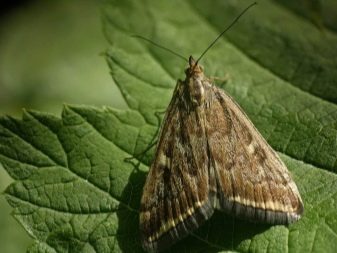
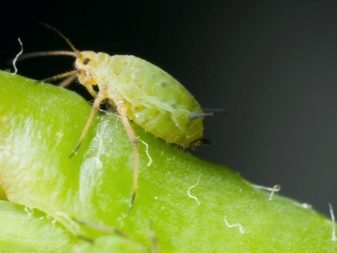
Application in landscape design
The bubble plant is actively used in landscape design projects. There are many successful examples of compositions at their summer cottage.
- when decorating flower beds, the plant looks very attractive;


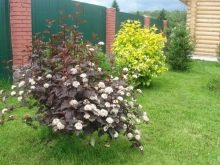
- the plant is often used as a hedge.
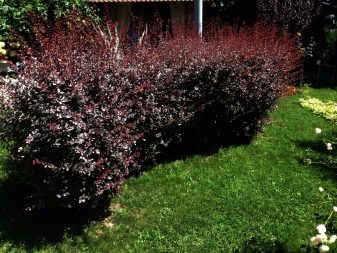
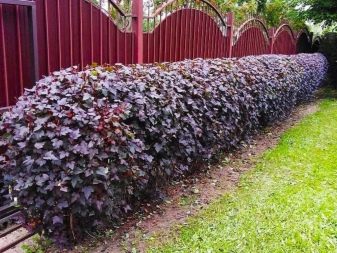































































The comment was sent successfully.